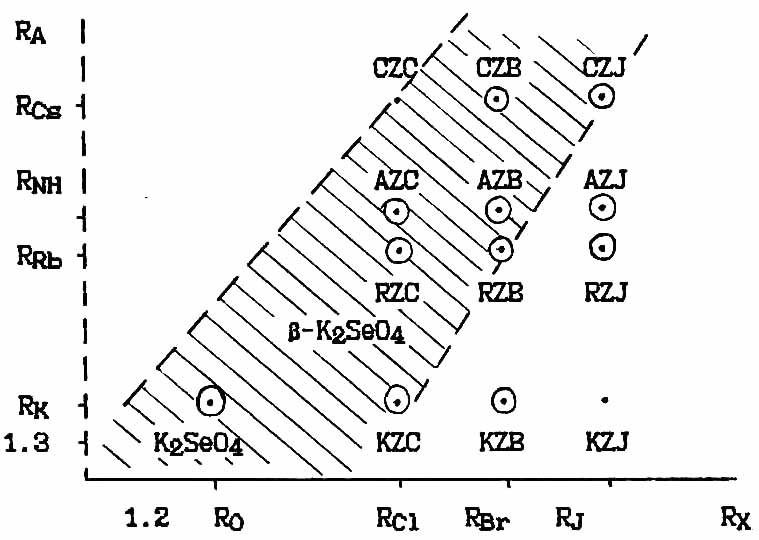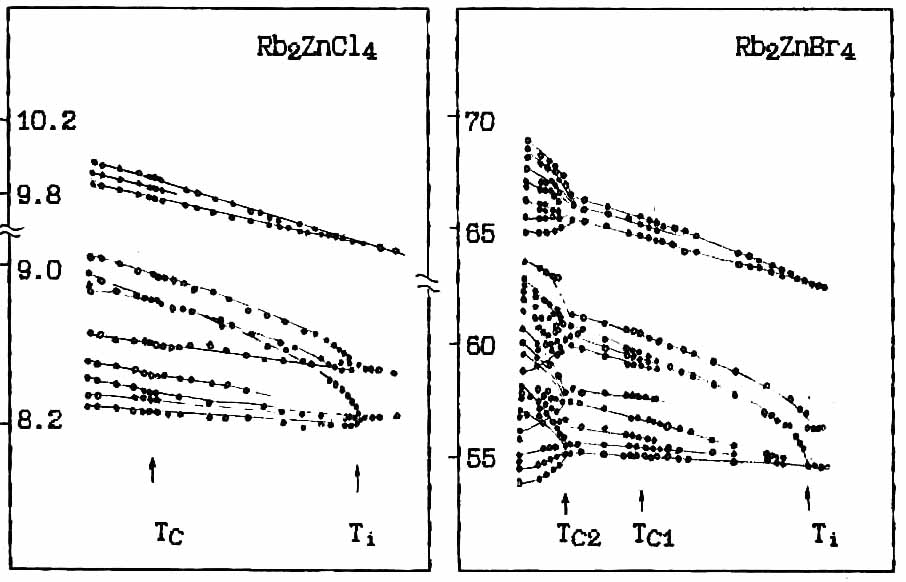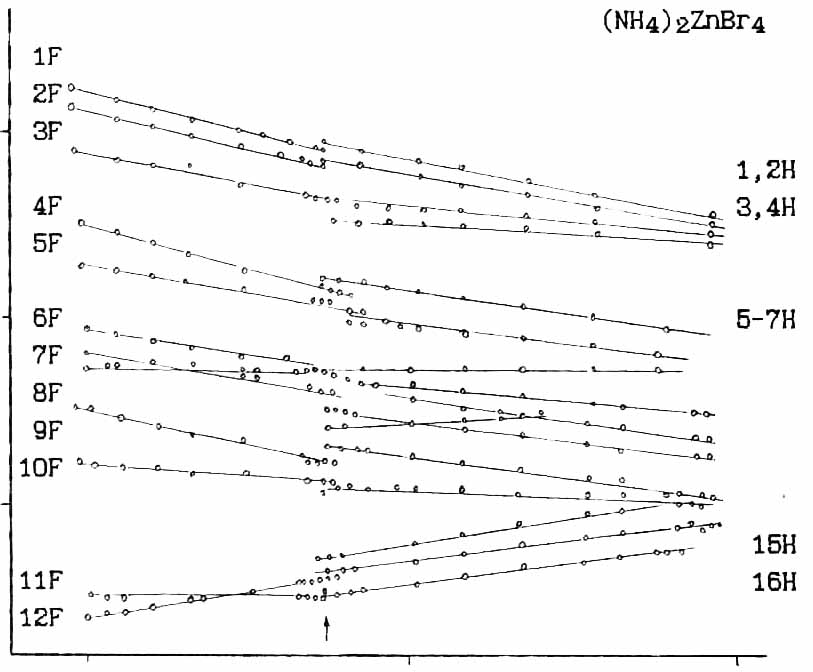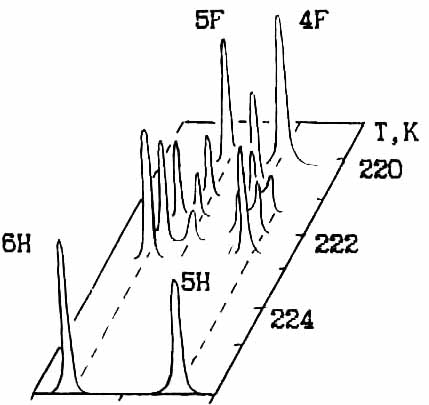SHEMETOV YEVGENY. STUDIES OF PHASE TRANSITIONS IN THE UNITED A2BX4 STRUCTURE β-K2SO4 METHOD NUCLEAR QUADRUPOLE RESONANCE
English abstract § 1.1 § 1.2 §1.3 § 1.4 § 2.1 § 2.2 §2.3 §2.4 § 3.1 § 3.2 § 3.3 § 3.4 § 4.1 § 4.2 § 4.3 § 4.4 Reference Template pdf abstract
§ 1.3 Experimental studies of families of compounds A2BX4 structure type β-K2S04.
By now, several hundred compounds of the chemical composition A2BX4 (A = K, Na, Rb, Cs, NH4 ...; B = Zn, S, Co, Mn, Cd, Mg, Se; X = F, Cl, Br, J. ..) with an octahedral, tetrahedral, and planar coordinations distorted anion X, relative to the atoms of type A 170 from various structures such composition is one of the most interesting type structure β-K2SO4, wherein the coordinating anion is close to the tetrahedral . In recent years, representatives of this structural type attract attention due to the discovery disproportionately modulated phases in compounds β-K2SO4 [2], Rb2ZnCl4 [39], K2ZnCl4 [37], Rb2ZnBr4 [38], (NH4)2ZnCl4 [39], Cs2HgBr4 [46] and others.
High-temperature phase β-K2SO4 is orthorhombic and space group D2h16(Pnma) (b>a>c) [40]. It is also assumed that this structure is praphase nonpolar structure with space group symmetry D6h4(P63/mm6). This structure was observed above T = 745K in K2SeO4 [58].
On the basis of structural studies in the literature formed the view that the diversity of family structures in the A2SBHal4, due to the high porosity of the core nucleus halogens and volatile cations A relatively small perturbation of the electron configuration of anions The connection A-A' in some cases resembled relation H-H'with two minimumnym potential [128].
Crystal-structure analysis of stability β-K2SO4 [4] made based on a comparison of anionic and cationic radii in the problem of dense packing gives the forecast for the region of stability of the structure (Figure 1.4). Experimental data indicate that the most structurally diverse compounds properties are located on the border of stability of structure β-K2SO4. Such compounds with various external effects exhibit, as a rule, a tendency to a sequence of phase transitions in less symmetrical, manner in the structural hierarchy, phase. In this sequence and implemented disproportionately modulated structure. In addition, the analysis of the crystal-chemical and experimental data indicates the possibility of the existence of another type of instability ion frame associated with symmetry-unrelated transformation structure.
Modulated phases owe their existence delicate balance intracrystalline interactions, which, as experience shows, can be easily broken. Preliminary theoretical studies of these interactions indicate that itself modulated structure can be represented by a sequence of higher level of symmetry. On the basis of these results, the physics can expect the discovery of new principles describe the crystalline state and the detection of previously unknown properties of dielectric solids.
Currently, research efforts are focused on the one hand to find and codify different structures in the incommensurate phase and a generalized phase diagram of these compounds and, on the other hand, figuring out the new features and capabilities to manage these structures.
Until the moment of this writing the most studied compounds were presented in Table 4.4. They all have high-temperature phase with the space group symmetry D2h16 (Rnma) and with decreasing temperature test sequence of phase transitions. SLCPresented in Table compounds can be divided into three groups according to the position of the symmetry in the Brillouin cell dew point of the soft mode: near the S-line, L-line and X-line. Incommensurate phases observed in these compounds have one-dimensional modulation, characterized by displacement of the atoms along the a, b or c directions "direct" lattice. As the temperature decreases observed sequence of phase transitions between phases with space group symmetry, which are sufficiently consistent scheme developed in [18]. The experimental data presented in the table 4.1 were obtained with the assistance of various macroscopic and structural measurements. All of these compounds were investigated radiospectroscopic methods. In most of the compounds detected the presence of

Figure 1.4. Stability domain structure β-K2SO4 for compounds A2ZnX4. (See the notation in Table. 3.1)
an incommensurate phase NQR, NMR and EPR. Below we will focus mainly on the NQR studies, and the results of other resonance techniques will attract only as needed As seen from Table 4.1, most of the nucleus of atoms of compounds have a nonzero quadrupole moment. However, from a practical point of view, are the most suitable halogen isotopes: J, Br and Cl. The nucleus of the last two have spin 3/2, and according to theory NQR can be in two doubly degenerate energy states [43]:
 (1.33)
(1.33)
 (1.34)
(1.34)
where Q - quadrupole moment; h - the asymmetry parameter; qzz - EFG component along the main axes of the tensor qab. In the absence of disturbances, for there is one observation of the NQR frequency change that is required to change the EFG at work at the core of the structural phase transformations. On the measurement of the NQR frequencies of non-equivalent structural positions of the nucleus based simplest methods NQR.
For quantum transitions between levels of quadrupole nucleus with spin different from 3/2 with more than two non-degenerate transitions, which is possible to observe the effect of "pure" NQR [24]. The most common methods of NQR are stationary when the spin system affects continuous RF field and unsteady - recorded when the system response to impulse action.
First NQR data in compounds A2BX4 (X-halogen) have been presented in [44,45]. For a large group of compounds by super-regenerative spectrometer were measured NQR frequencies at room temperature and the boiling point of nitrogen. It was noted that in some compounds the signals are not observed or observed only partially and incontradiction with the diffraction structural data The pioneering research NQR incommensurate phases were performed in in IF SB AN USSR A.K.Moskalev and et al. [36] and IN&OCh AS USSR G.K.Semin [46]. In these papers to study incommensurate phases was applied pulse NQR method. In the first of the cited work was to study the evolution of the NQR spectra in the crystal Cs2ZnCl4 and built the temperature dependence of the frequency dependences of nucleus 35C1 (Figure 1.5). [46] studied the compounds Cs2HgBr4, where the authors observed NQR spectra in the incommensurate phase. Following work was performed at the junction of Rb2ZnBr4 [38], where the NQR spectra were studied in the incommensurate phase and frequency dependence is built in a wide temperature range (Figure.1.5b).
Given the experimental data of [36,33,38] on the basis that existed at that time, theoretical ideas about the disproportionate state model was proposed femenologicheskaya cancellation resonance line shape evolution in the incommensurate phase [33]. The frequency distribution of NQR spectra have been analyzed in the framework of the plane-wave approximation and the soliton. On the basis of the calculated line shape fit to the experimental qualitative agreement was reached with the description of the proposed model of the incommensurate phase in the framework of the plane wave approximation [34]. However near TC agreement was unsatisfactoryIn this area, there was an attempt to describe the theory of Dzyaloshinskii-Landau, through the concept of identifying the density of solitons with the order parameter of the phase transition to the ferroelectric phase.
Another attempt to study the incommensurate phase was undertaken in K2ZnCl4 stationary NQR method [37]. At room temperature, as in [44], with the resonance lines 6 35C1. However, in the incommensurate phase NQR signals were observed only near Ti, the position (I) C135 nucleus in the structure Pnma. The absence of signals from other nucleus 35C1 explained significant reorientation of the ZnCl4 tetrahedra around its axis passing through the position of the nucleus Cl(1) and coincides with the axis . symmetry structure.
In 1980 he was made a comprehensive study of the compounds Cs2HgBr4 and Cs2CdBr4 [48] and the observed sequence of phase transitions shown in Table 4.1. Using pulse technology NQR was tracked the temperature dependence of the frequency, while in the incommensurate phase NQR signals were observed only on the position. I core structure Rnma 81Br. Line shape in the Jc-phase had continual distribution and attempted to describe it as part of the plane wave approximation model [33].However pronounced asymmetry form was not explained clearly. Signs soliton picture offset was observed.
Compound (NH4)2ZnCl4 and (NH4)2ZnJ4 also were first investigated by NQR in Krasnoyarsk IF [39,49]. In the first of these compounds, in the temperature range from 271K to 266K, anomalous behavior of NQR spectra in which 16 high-temperature phase of singlet lines are mapped to 12 NQR lines below 266 value of qs are diffraction methods.
The main advantages of pulsed rf is the possibility of direct measurement of the spin-spin Tq2 and spin-lattice relaxation time Tq1 system. This information, as noted above, is of great value for the study of the dynamics of the system in a critical phase transition region.
Blintz and coworkers [33] were measured by NMR Tq1(T) and Tq1(n)for the core 87Rb in the compounds RbK. In the intermediate temperature range was registered incommensurate phase. NHZnrIn (NH4)2ZnJ4 similar type anomaly was observed at 222K in 4K (Figure 1.6). In these compounds, involving other methods, later was detected and other phase transitions indicated in Table 4.1.
RF methods have been reported and studied incommensurate phases in the (NH4)2BeF4 and {TMA}2ZnCl4 (see the references in [33]).
Thus, a simple observation made by NQR can detect incommensurate phases.
Simultaneously with the work described above, for several years compounds with β-K2SO4 and studied all sorts of other methods, and to date there is sufficient information on the properties of the phases and characteristics of phase transitions for each compound. The major method allows to measure directly the2ZnBr4 and Rb2ZnClBr. Results were compared with theory. In the P-Jc transition usually observed critical shortening Tq1, which, as stated by the authors, was not contrary softly-mode description. In Jc phase in a wide temperature range Tq1 ivmenyaetsya little with temperature and is abnormally short. Originally it was explained the predominant influence of phason excitations in the entire region of the incommensurate phase. However, studies in the high part of the measurement phase and Jo Tq1 in metered-doped solid solution (Rb1-xKx)2ZnCl4 (x = 0, 0.02, 0.06) [52] reported significant influence of impurities on the behavior of Tq1 in Jc phase transition at TC. At x = 0, the value Tq1 was reduced and observed at TC Tq1 races.
In conclusion, the experimental part of the review, we note some kinetic phenomena observed in the incommensurate phases. In studies of systems with dipole density waves

Figure 1.5. Temperature dependence of the frequency of the NQR lines of Rb2ZnCl4 and Rb2ZnBr4
 MHZ
MHZ
65
60
150 TC 250 350 Т,К

Figure 1.6. Temperature dependence of the frequency and the change in T C line intensity 5F and 6F NQR spectrum in the (NH4)2ZnBr4.
(which include dielectrics and modulated with a structure of β-K2SO4) in the incommensurate phase were found by macroscopic nonequilibrium processes that are a little earlier, were seen in systems with charge density waves [63]. One of these phenomena, called global hysteresis is the presence of a kind of hysteretic behavior was observed in the entire region of the incommensurate phase [60,62]. A typical illustration of this behavior is mutually reciprocal transition between states I«II characterized by the magnitude of the inverse susceptibility 1/(c-cо) (corresponding to the cooling mode (I) or heating (II) when the direction of the sample temperature in the opposite Jc phase near TC [62]). When the temperature stop Tstop > TC trend approximation value 1/(c-cо) to some equilibrium state III. However, if after stopping, the direction of change of temperature is stored, the temperature during the reverse stroke, when the temperature T'S observed small leap 0.01% of the measured macroscopic susceptibility. The temperature T'S, up to a temperature hysteresis stop coincides with the temperature TS [61]. This phenomenon has been referred to the effect of thermal memory. Additionally in studying samples doped Rb2ZnBr4, it was found that the form of the hysteresis curves of dielectric measurements depends on the prehistory of the sample [60]. Initially, these nonequilibrium phenomena explained by the interaction of the modulation wave soliton configurations with mobile defects. In this model competition soliton-soliton and soliton-defect interaction at fixed external conditions for quite a long time leads to the establishment of a quasi equilibrium system micro configuration. Conditions change and subsequent recovery, after a time shorter than the diffusion of defects, their distribution is correlated with the quasi-equilibrium conditions for the data configuration of solitons. However, theoretical estimates to quantify the magnitude of this effect in real crystals [62], as well as direct electron microscopic observation of the actual configuration of the walls transform domain disproportionate Rb2ZnCl4 and 2H-Ta2Se [53] pointed out that the main mechanism of the transformation of the soliton strktury are the processes of formation (destruction) of anti-germ incommensurate phase (stripple nuciies) [62,63]. The unit consists of a single nucleus (P = 2) or more (P > 2) regions with incommensurate structure, surrounded on all sides by the other incommensurate structure. Structures differ in the magnitude of the phase

and separated soliton walls. The walls of the embryo in their intersection to form a special (topological) defect. With the growth or dissolution of embryos there are significant elastic force impeding change its volume (in the case of the strong interaction of the topological defect with a matrix structure of the crystal). Due to this, the system has significant internal friction, preventing movement of the defect and an inhomogeneous stress. Development of the latter may result in an increase of the same type at the expense of other domains, as well as affect the amount of phase change in the domain walls

English abstract § 1.1 § 1.2 §1.3 § 1.4 § 2.1 § 2.2 §2.3 §2.4 § 3.1 § 3.2 § 3.3 § 3.4 § 4.1 § 4.2 § 4.3 § 4.4 Reference Template pdf abstract